The History of Russkit

In 1959, 34-year-old Jim Russell was looking for something to do on a weekend when a friend introduced him to a novel new hobby called slot car racing. Russ, as everyone calls him, was hooked.
Then, in early 1963 while refinishing a coffee table, some Behr varnish spilled on one of Jim’s cars. He didn’t notice until after it dried but the effect was dramatic. Ever the entrepreneur, Jim decided to market his discovery and a new product and company were born.
Russkit was incorporated in November of 1963 but its first product, Russ-Coat, actually hit the shelves in the summer of that year. Russell had quit his job as an accountant and management consultant in April to concentrate on getting a product line together for the new company so he started selling out of his car while he put together the financing and organization for the enterprise. The timing couldn’t have been better as interest in slot cars was just starting to climb. But the cars of that time were limited by the technology, or lack of it. They were heavy, and not very fast and it was a challenge just getting them around a track. Still, the injection molded bodies were impressively realistic and it was an exciting experience to “race cars” in your garage.
Jim was all about performance and immediately started making changes to make them go faster and handle better. And many of those improvements became new products for the young company. Here is a partial list of products and marketing “firsts” that flowed from Russkit:
- First production vacuum formed bodies for RTR cars – lighter weight, more durable than Injection molded
- First slot car application for “can” style Mabuchi motor – lightweight variant became the famous “16D”
- First Drop Arm Guide – arguably the best ever made
- First hinged chassis – transferred weight in corners to improve handling
- Unique “Pit-Kit” packaging – Box became carry pack, kids would carry them to the slot car tracks
- Adjust-O-Jig – Made it easier for anyone to make their own hand-built chassis
- First Trigger-Finger controller – Original patented design still in use over 40 years later
- First professional “Factory” race team – Toured the country competing and giving demonstrations
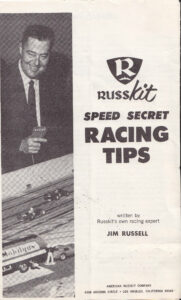
The environment was special – a lot of bright, young enthusiasts fired up and having fun. Here is a short list of some of the people who worked with or for Russkit under Jim:
- Bob Braverman – Top flight fabricator from aerospace. MESAC member.
- Chris Chan – Did much of advertising and logos. Later designed the AFX Logo for Jim at Aurora
- John Cukras – Pro slot racer and R&D guy. Did testing and R&D projects. One of the leaders of the teams that designed the G+, Super G+, and others.
- Jack Duer – Engineer had his hand in almost all of the Russkit products.
- Rick Durkee – One of the original Team Russkit members
- Dick Gray – Sales manager
- Jim Kirby – Started out sweeping floors, eventually a top-drawer R&D guy. Brought to New York by Russell and made Product Manager for T-Jets at Aurora.
- Ron “Von” Klein – Carved many of the Russkit bodies. Brought to Aurora in 70’s by Russell to carve some of the most beautiful HO bodies ever made.
- Mike Morrisey – Founding member and leader of the original Team Russkit
- Ron Quintana – One of the original Team Russkit members
- Hank Rose – Russell’s business partner, well-known lawyer.
- Len Vucci – One of the original Team Russkit members
- Ed Wadleigh – Salesman
- John Wessels – Designer and engineer had a hand in many of Russkit innovations. Later headed Russell’s “Skunkworks” in California that created the G+.
Team Russkit 1:1
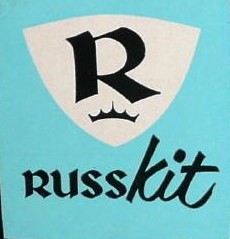
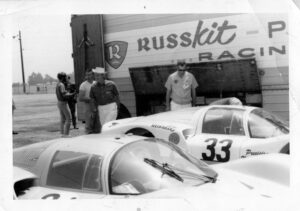 Jim’s love of racing made it easy to rationalize the marketing “need” to sponsor full sized racing teams and by 1965 the company had grown large enough to support this dream. It started with the low-level support of some of the better-known sports car stars of the day: Lance Reventlow, Dan Blocker, but of course, it wasn’t enough. And as he got to know more of the personalities of the sport he took Russkit into sponsorship of entire teams.
Jim’s love of racing made it easy to rationalize the marketing “need” to sponsor full sized racing teams and by 1965 the company had grown large enough to support this dream. It started with the low-level support of some of the better-known sports car stars of the day: Lance Reventlow, Dan Blocker, but of course, it wasn’t enough. And as he got to know more of the personalities of the sport he took Russkit into sponsorship of entire teams.
In the mid-sixties, racing was still a gentleman’s sport and logos were rarely seen on racing cars. So it was a little odd when The Russkit logo showed up on the Haskell/Wexler Lola T70 of Ronnie Bucknam. But it didn’t take long for the others to get on the bandwagon. Jim went on to sponsor the unofficial factory Porsche team of Estes/Zipper in 1966 with a two car team and drivers Ken Miles and Scooter Patrick. That team won the National Championship of the day, the CSPRRC.
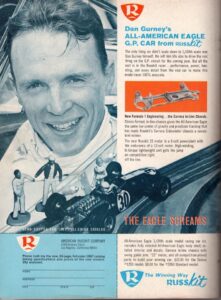
At one of the races that year, Jim was talking with Carroll Shelby who mentioned 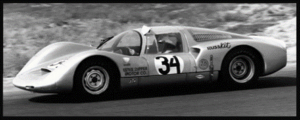 that they were getting ready to crush the Cobra Daytona Coupes that had been so successful in GT racing over the prior two years. Jim offered to buy the original coupe, chassis number CSX2287 to use it for promotional display at the west coast races during the year. Shelby agreed and sold the car to Jim for $4,500. Strictly in the interest of saving money you understand, Jim hit on the idea of converting the car to street legality so it could be driven to the races instead of needing a trailer. This meant that Jim would have to make the ultimate sacrifice of driving the car on the street. Stepping into the breach, he steadied himself and drove the car back and forth to work many times while he had it. The sound of this 200mph supercar firing up in the driveway would bring kids out of the neighboring houses just to see it pass.
that they were getting ready to crush the Cobra Daytona Coupes that had been so successful in GT racing over the prior two years. Jim offered to buy the original coupe, chassis number CSX2287 to use it for promotional display at the west coast races during the year. Shelby agreed and sold the car to Jim for $4,500. Strictly in the interest of saving money you understand, Jim hit on the idea of converting the car to street legality so it could be driven to the races instead of needing a trailer. This meant that Jim would have to make the ultimate sacrifice of driving the car on the street. Stepping into the breach, he steadied himself and drove the car back and forth to work many times while he had it. The sound of this 200mph supercar firing up in the driveway would bring kids out of the neighboring houses just to see it pass.
Unfortunately, the slot car craze was waning and the slot car shops, that at one point nearly outnumbered bowling alleys, began to close. And by 1968 the market was in a full nose-dive. The Daytona Coupe was sold in 1967 to music impresario Phil Spector (Wall of Sound, Righteous Brothers, celebrity partyer, noted gunman) to meet payroll. Selling price: $12,500. (The same car recently sold for $4,500,000. Oh well!)
Finally, in 1969, Jim closed Russkit. He liquidated the assets and was able to pay off almost all of his debts. Chuck Diker of Aurora Plastics Company approached him and wanted Jim to work in New York and sell Aurora the patents on the Russkit controller. This contract allowed Jim to pay off the Russkit debt and set the stage for the creation and stunning growth of AFX. But that’s another story…
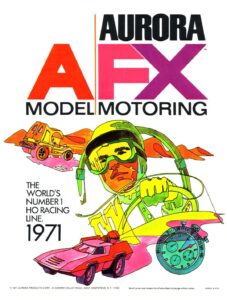
READ NEXT
The History of Aurora/AFX or The History of Racemasters
